| | The essence of a good chess photograph is simply capturing an emotion in time and space; like a mime, the players dance through many thoughts and feelings in the course of a chess game. My goal is to be ready to see a possibility and to be lucky enough to snap the shutter in time to get what I imagined—what I put together in my brain, on my mental canvas. So a good chess photograph is planning, spacing and being lucky. We are dealing with composition and relations among things, like heads, hands, pens, pieces, clocks; and colors. Now colors can enhance a photo or burn it out visually. When things get too bright and too crazy, I mellow things down with black and white or an antique tint. My goal in chess photography is twofold: firstly I want to make the subject, i.e. the player, look good. Secondly, I want to portray a chess game or a chess activity as worthy of note and inviting to the viewer to be inclined to want to participate in the chess world, either by playing chess or coming over to watch an event. My bottom line is: I am promoting the sport of chess through my efforts as a chess photographer.
I won the Chess Journalists of America award for “Best New Magazine” for 1996: Chess Pioneers, which included my photos, chess stories and game analysis of scholastic player in Massachusetts. I have taken many photos in my career as a chess photographer and journalist. I am proud of my Chess Horizons covers: Susan Polgar Simul (Jan. 1986); Ilya Gurevich plays Pat Wolff (Sept. 1986); Pat Wolff (Sept. 1987); Mikhail Tal (June 1988); Victor Frias, Dzindzihasvili, Pat Wolf, (Aug. 1988); Boris Gulko, (June 1989); Gary Kasparov (Dec. 1989) Anatoly Karpov (1990); Leonid Yudasin, (Dec. 1990); Sofia and Judith Polgar (Dec. 1993); Carissa Yip (Summer, 2013). My photos have also been published in Chess Life, Inside Chess (Seattle, WA), New in Chess (Holland), Schachwache (Switzerland) and the British Chess Magazine.
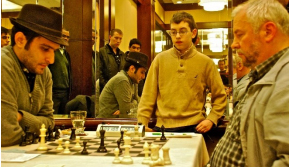 The basic ingredients of a photo: TIME and SPACE: these are the two components which interact and weave a relation among objects caught in the click of the shutter, to portray a particular visual statement. A good photo speaks to you, without words. What translates the image caught in time, is the way the human brain works to analyze and decode a visual image and makes sense of it: human sense. Like a chess game, there are the “rules” of optics and esthetics. Covering a chess tournament includes many challenges. For example, my photo of GM Elshan Moradiabdi vs GM Alexander Ivanov, Round 4, Boston Chess Congress, 2014, with the young lad Michael Isakov looking on. The subjects are silent, motionless. The drama is frozen, yet intense. I had the good luck to be able to actually sit down next to Ivanov(the game Yedidia-Hungasky, Board 2, had just concluded in a draw when I arrived, leaving the space vacant to my good fortune). So I seized the opportunity. The viewer can see that Elshan had 31 minutes on his clock, and Ivanov, always a time-pressure addict, had 1 minute and 50 seconds (with 10 second delay); I had seen Michael walking around, showing interest in this Board 1 grandmaster game so I had the presence of mind to call him over and point to stand right between the two players. Of course all has to be done silently as humanly possible, so as not to distract the players. Luckily my efforts to “build” a good photo and Michael’s quiet walk to the center of action went on without a problem. For this photo, I just waited for the right moment and: “click”. Yes there’s a slight noise of the shutter. But in less than a second, it is over. No perceived distraction. It goes without saying that I do not use flash taking chess photos. Not only would that ruin the eyes of my subjects (squinting) but I would be thrown out on my ear, if not by the players, then by the TD. No, flash is definitely out. The basic ingredients of a photo: TIME and SPACE: these are the two components which interact and weave a relation among objects caught in the click of the shutter, to portray a particular visual statement. A good photo speaks to you, without words. What translates the image caught in time, is the way the human brain works to analyze and decode a visual image and makes sense of it: human sense. Like a chess game, there are the “rules” of optics and esthetics. Covering a chess tournament includes many challenges. For example, my photo of GM Elshan Moradiabdi vs GM Alexander Ivanov, Round 4, Boston Chess Congress, 2014, with the young lad Michael Isakov looking on. The subjects are silent, motionless. The drama is frozen, yet intense. I had the good luck to be able to actually sit down next to Ivanov(the game Yedidia-Hungasky, Board 2, had just concluded in a draw when I arrived, leaving the space vacant to my good fortune). So I seized the opportunity. The viewer can see that Elshan had 31 minutes on his clock, and Ivanov, always a time-pressure addict, had 1 minute and 50 seconds (with 10 second delay); I had seen Michael walking around, showing interest in this Board 1 grandmaster game so I had the presence of mind to call him over and point to stand right between the two players. Of course all has to be done silently as humanly possible, so as not to distract the players. Luckily my efforts to “build” a good photo and Michael’s quiet walk to the center of action went on without a problem. For this photo, I just waited for the right moment and: “click”. Yes there’s a slight noise of the shutter. But in less than a second, it is over. No perceived distraction. It goes without saying that I do not use flash taking chess photos. Not only would that ruin the eyes of my subjects (squinting) but I would be thrown out on my ear, if not by the players, then by the TD. No, flash is definitely out.
One parenthetical note. There are many “big money” or GM tournaments which rope off the top boards, so the spectators don’t get too close. Had this been the case at the Boston Chess Congress, I would have had to use a different camera strategy to get a good shot, using my telephoto lens. Luckily, I was able to sit right next to the action, watch the game, appreciate the chess as well as photograph the moment. This makes for a great synthesis of my emotional energy and enthusiasm for what I am photographing, stimulating me to use my mental concentration to produce a worthwhile photograph. In this way, I am sharing my enthusiasm for the sport of chess, as I wish to “turn on” the general public to chess and enough so, get them to venture out to watch chess events, and to even have the courage to play chess! A side note: the game between Moradiabdi and Ivanov was eventually drawn. Elshan had 12 minutes left on his clock, Ivanov 33 seconds. White had a win at some point in the rook and pawn endgame but did not find it during the intense silence of play. This is part of chess too: what is not found in time, under extreme mental stress!
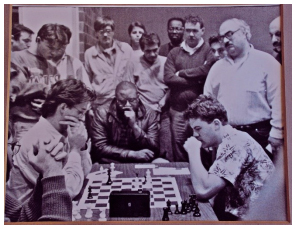 Let me talk about my two bast action chess photos, one from the "first MACA Game 60 Championship" Watertown, MA, at Armenian Cultural Center 1990. Remember this place, you veterans of chess? The players: On the left, playing the black pieces, was Girome Bono, (USCF 2430) and playing white, Alex Sherzer (2620) on the right. The setting: Round 4. Bono was in time pressure. There was an issue concerning “the writing down of moves/ or not” between the players which heightened the already high-tension situation. George Mirijanian, the event Chief TD was called over to resolve the dispute and keep “things” from exploding. The viewer of the photo can see that after all the commotion by the players, the spectators became super-charged with excitement and tension. The players were smoking hot, but you see that both these players are veteran chess masters who have many tournaments under their belts, so they did not betray their emotions to each other or to the public—poker faces! But the faces of the crowd reflected the tension! Let me talk about my two bast action chess photos, one from the "first MACA Game 60 Championship" Watertown, MA, at Armenian Cultural Center 1990. Remember this place, you veterans of chess? The players: On the left, playing the black pieces, was Girome Bono, (USCF 2430) and playing white, Alex Sherzer (2620) on the right. The setting: Round 4. Bono was in time pressure. There was an issue concerning “the writing down of moves/ or not” between the players which heightened the already high-tension situation. George Mirijanian, the event Chief TD was called over to resolve the dispute and keep “things” from exploding. The viewer of the photo can see that after all the commotion by the players, the spectators became super-charged with excitement and tension. The players were smoking hot, but you see that both these players are veteran chess masters who have many tournaments under their belts, so they did not betray their emotions to each other or to the public—poker faces! But the faces of the crowd reflected the tension!
Bono, a Harvard Graduate, was the older of the two players. Sherzer was an undergraduate at Rhode Island College on a full chess scholarship. Bono was a bit rusty, not having played tournament chess for a while; Sherzer was playing on a weekly basis up to the point of this event. And, chess-wise, Sherzer had the advantage of the white pieces. Things got stormy and pulsating as the flag of Bono’s clock started to rise: tension—you could cut it with a knife. Sherzer had at the end of things around 5 minutes on his clock. These are analogue clocks, no delays, no digital read-outs. You have to guess how much time you have as your flag goes up (and hopefully not down before you finish your game)! Sherzer by the end had a forced win. Bono valiantly marched on, trying to keep his game together. Yet, the damage was too great. Sherzer was about to checkmate as Bono’s flag fell. This was the most tense chess game I have ever witnessed, and had the good luck to be ready to take a photo of the tension. You see it in all the people, including the players: hands on lips! This is a common gesture when a person is absorbing tension for whatever reason. And again, I was lucky enough to catch the moment, to tell the story, visually. A short while after this event, Alex Sherzer was awarded the grandmaster title!
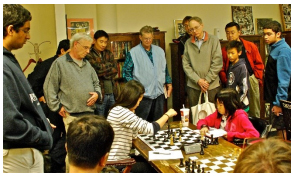 My only 21st Century time-pressure crowd shot, so far, was a situation occurring at the Boylston Chess Club, during October, 2013, in the third round of a Grand Prix event. To my delight, I was taking a photo of two of the most talented women chess players in Massachusetts. I have always been a strong advocate of recruiting girls and women to play chess and especially chess tournaments! And here I was witnessing great chess being performed in mutual time-pressure by two young women, one a 19 year old MIT undergraduate, the other a 10 year old, the youngest USCF girl expert in history! You can’t get better than that! So at the time I snapped my photo, Yang Dai (left) had 33 seconds left on her clock (5 second delay) and Carissa Yip was about to lose the game on time-forfeit. The crowd, as the viewer can see, loved every minute of this epic battle. Not an eye strayed from the chess board! [Just a note of information: the TD for this event, Bernardo Iglesias, was watching the activities of this time-pressure saga. He is standing 3rd from the left—you see a bit of his black hair.] The appraisal of the chess position at the time of the forfeit: dynamic equality, in a locked up center! My only 21st Century time-pressure crowd shot, so far, was a situation occurring at the Boylston Chess Club, during October, 2013, in the third round of a Grand Prix event. To my delight, I was taking a photo of two of the most talented women chess players in Massachusetts. I have always been a strong advocate of recruiting girls and women to play chess and especially chess tournaments! And here I was witnessing great chess being performed in mutual time-pressure by two young women, one a 19 year old MIT undergraduate, the other a 10 year old, the youngest USCF girl expert in history! You can’t get better than that! So at the time I snapped my photo, Yang Dai (left) had 33 seconds left on her clock (5 second delay) and Carissa Yip was about to lose the game on time-forfeit. The crowd, as the viewer can see, loved every minute of this epic battle. Not an eye strayed from the chess board! [Just a note of information: the TD for this event, Bernardo Iglesias, was watching the activities of this time-pressure saga. He is standing 3rd from the left—you see a bit of his black hair.] The appraisal of the chess position at the time of the forfeit: dynamic equality, in a locked up center!
 Another “crowd” shot was my photo of a postmortem and analysis by NM Eric Godin, who was critiquing a game he had just played against Ryan Sowa at a Boylston tournament, with white in a line of the French defense. Also seated at the chessboard, opposite Ryan, is Conway Xu, who Eric beat in the same line of the French the previous Saturday. The people in this photo listening to Eric’s lecture on the French were some of the players in the tournament and the parents of the younger players. The trick in doing a large group photo like this is to get everyone one the same page so to speak: not walking out of or into the photo, or turning heads away from the action, or picking their nose. Everything has to be presentable and in sync. And the more people you have in the frame, the more chance there is for something to go wrong visually. So this photo embodies a lot of good luck, to say the least! Another “crowd” shot was my photo of a postmortem and analysis by NM Eric Godin, who was critiquing a game he had just played against Ryan Sowa at a Boylston tournament, with white in a line of the French defense. Also seated at the chessboard, opposite Ryan, is Conway Xu, who Eric beat in the same line of the French the previous Saturday. The people in this photo listening to Eric’s lecture on the French were some of the players in the tournament and the parents of the younger players. The trick in doing a large group photo like this is to get everyone one the same page so to speak: not walking out of or into the photo, or turning heads away from the action, or picking their nose. Everything has to be presentable and in sync. And the more people you have in the frame, the more chance there is for something to go wrong visually. So this photo embodies a lot of good luck, to say the least!
Let me take the opportunity to tell the Chess Horizon readers that my photos are found on a weekly basis on the Boylston Chess Club Weblog (google up: “Boylston Blog”) I am looking forward to summer, as I am sure all of you are, a time when the weather is warm and the Au Bon Pain Café plaza is full of chess players with off-hand games, and clock blitz games going on and lots of interesting people roaming around to chat with, from all over the world. It is in this venue that I have taken some of my best outdoor photographs, including Yuanling Yuan (pictured below, playing 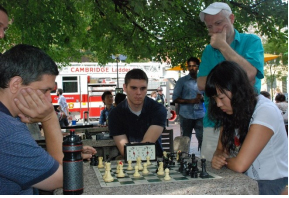 against a Harvard Square regular), born in Shanghai, living in Toronto, schooling at Yale. She visited Harvard Square in 2012. I photographed her at that time and also when she came as Board 2 of the Yale 4 board chess team—GM Robert Hess was on Board 1!—to play Harvard (the match was drawn). Yuanling is the highest rated woman chess player in Canada (around USCF 2400+ level). Anya Corke, a former chess champion of Hong Kong, also visited Harvard Square with her dad. Anya played a few tournaments at the Boyston Chess Club and won one. She is a recent graduate of Wellesley College. against a Harvard Square regular), born in Shanghai, living in Toronto, schooling at Yale. She visited Harvard Square in 2012. I photographed her at that time and also when she came as Board 2 of the Yale 4 board chess team—GM Robert Hess was on Board 1!—to play Harvard (the match was drawn). Yuanling is the highest rated woman chess player in Canada (around USCF 2400+ level). Anya Corke, a former chess champion of Hong Kong, also visited Harvard Square with her dad. Anya played a few tournaments at the Boyston Chess Club and won one. She is a recent graduate of Wellesley College.
I was hoping that Magnus Carlsen would make a surprise visit to Harvard Square this summer. He was last in Cambridge, MA at Loeb House last October, where he played a 10 board simul to international lawyers in town for a conference on trade and patents. Carlsen won all ten games - not bad for a blind-fold exhibition against strong chess amateurs. And though I still await the world chess champion’s next visit to Cambridge, the summer did not disappoint.
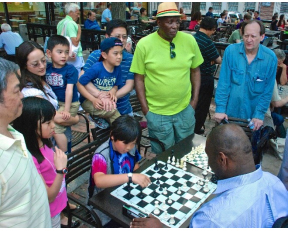 On June 10, 2014, at the Au Bon Pain Chess Cafe, Harvard Square, Cambridge, MA, the super-kids of chess convened. Two action shots illustrate the family nature of youth chess: first, Corey Tolbert, an A-Player and Bullet Chess Master challenging Connecticut’s Max Lu, top 8 year old in the Connecticut’s Max Lu, top 8 year old in the right) Percy Yip, daughter Carissa (No. 1 10 yr old in MA) On June 10, 2014, at the Au Bon Pain Chess Cafe, Harvard Square, Cambridge, MA, the super-kids of chess convened. Two action shots illustrate the family nature of youth chess: first, Corey Tolbert, an A-Player and Bullet Chess Master challenging Connecticut’s Max Lu, top 8 year old in the Connecticut’s Max Lu, top 8 year old in the right) Percy Yip, daughter Carissa (No. 1 10 yr old in MA) 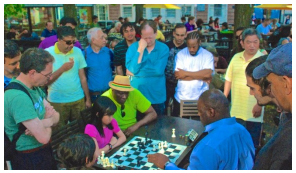 Lina Xu holding five-year-old son Evan, Jiong Wei, holding eight-year-old son Eddie, Professor Jerry Williams, chess patron and tournament player, and Paul Godin, local chess denizen, standing around the tables. Below, Carissa Yip (pink) plays black vs Corey Tolbert (blue) while a rather large crowd of chess enthusiasts observe the spectacle of a five-minute game. Lina Xu holding five-year-old son Evan, Jiong Wei, holding eight-year-old son Eddie, Professor Jerry Williams, chess patron and tournament player, and Paul Godin, local chess denizen, standing around the tables. Below, Carissa Yip (pink) plays black vs Corey Tolbert (blue) while a rather large crowd of chess enthusiasts observe the spectacle of a five-minute game.
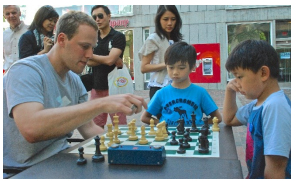 And finally, the June 23, 2014 photo session featuring Elia Samuel Harmatz, MIT neuroscientist who will see his first scientific paper on face recognition published by the end of the summer. My best photo ever of a casual encounter of a chess game, it features the Philadelphia, PA native playing a boy from Kuala Lumpur, while the challenger’s friend from Hong Kong observes. In the background, left to right: Paul from Cambridge, the visiting player’s mom and dad, and the mother of the boy from Hong Kong, at the Au Bon Pain Café, Harvard Square, Cambridge, MA. And finally, the June 23, 2014 photo session featuring Elia Samuel Harmatz, MIT neuroscientist who will see his first scientific paper on face recognition published by the end of the summer. My best photo ever of a casual encounter of a chess game, it features the Philadelphia, PA native playing a boy from Kuala Lumpur, while the challenger’s friend from Hong Kong observes. In the background, left to right: Paul from Cambridge, the visiting player’s mom and dad, and the mother of the boy from Hong Kong, at the Au Bon Pain Café, Harvard Square, Cambridge, MA.
In general, my chess photography highlights the fact that not only is chess international and universal, but also a family affair, linking parents and children, brothers and sisters, and of course, the indispensable grandparent, who bring the kids to the chess tournament and stay the entire day while the parents are out working. And even Bobby Fischer himself was promoted by his mother to launch a career at the very pinnacle of the game. |